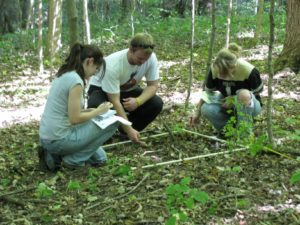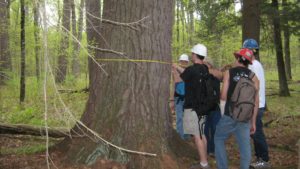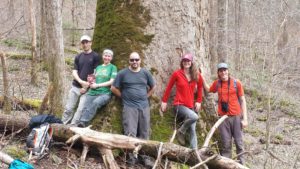Because forestry is a practical field, I believe that courses should be hands-on experiences where students work in groups to find the solutions to real world questions. While ecological concepts are important, field laboratories and the collection of data are critical to understanding the function and management of forest ecosystems. At Purdue, I teach classes to both graduate and undergraduate students that focus on both conceptual and practical aspects of forest ecology with a focus on ecosystem function, the role of disturbance, and management applications.
FNR 331 – Forest Ecosystems
 This course provide students with a basic understanding of how environmental factors, disturbance, and biotic interactions influence the function and structure of forest ecosystems. Emphasis is placed upon students achieving an integrated understanding of ecological concepts in both managed and unmanaged systems. Students also learn basic field techniques to assess herbaceous and woody species composition, overstory structure, and the volume and distribution of coarse woody debris.
This course provide students with a basic understanding of how environmental factors, disturbance, and biotic interactions influence the function and structure of forest ecosystems. Emphasis is placed upon students achieving an integrated understanding of ecological concepts in both managed and unmanaged systems. Students also learn basic field techniques to assess herbaceous and woody species composition, overstory structure, and the volume and distribution of coarse woody debris.
FNR 37050 – Forest Habitats and Communities Practicum
 To effectively manage natural resources, professional foresters and wildlife biologists must understand the complexity of managing habitats and biological communities. This course is designed to introduce students to basic concepts of community and ecosystem ecology by focusing on the diversity within the Upper Peninsula of Michigan. This is a week-long field based course where students use game cameras, habitat typing field keys, nested vegetation plots, and transect surveys to assess forest communities and wildlife habitat. This course is co-taught with Dr. Elizabeth Flaherty.
To effectively manage natural resources, professional foresters and wildlife biologists must understand the complexity of managing habitats and biological communities. This course is designed to introduce students to basic concepts of community and ecosystem ecology by focusing on the diversity within the Upper Peninsula of Michigan. This is a week-long field based course where students use game cameras, habitat typing field keys, nested vegetation plots, and transect surveys to assess forest communities and wildlife habitat. This course is co-taught with Dr. Elizabeth Flaherty.
FNR 536 – Ecology of Disturbance
 This course examines the theories and concepts of disturbance in a variety of ecosystem. Student read and discuss classic and contemporary papers to determine how viewpoints on the role of disturbance have evolved, how disturbance is related to taxonomic and functional diversity, how disturbance regimes differ within and across biomes, and how disturbance-based management is applied in forestry. The course includes a week-long field trip to Great Smoky Mountains National Park where students observe class concepts in the field and interact with park staff to learn how concepts are applied through active management. This course is co-taught with Dr. Michael Saunders.
This course examines the theories and concepts of disturbance in a variety of ecosystem. Student read and discuss classic and contemporary papers to determine how viewpoints on the role of disturbance have evolved, how disturbance is related to taxonomic and functional diversity, how disturbance regimes differ within and across biomes, and how disturbance-based management is applied in forestry. The course includes a week-long field trip to Great Smoky Mountains National Park where students observe class concepts in the field and interact with park staff to learn how concepts are applied through active management. This course is co-taught with Dr. Michael Saunders.
